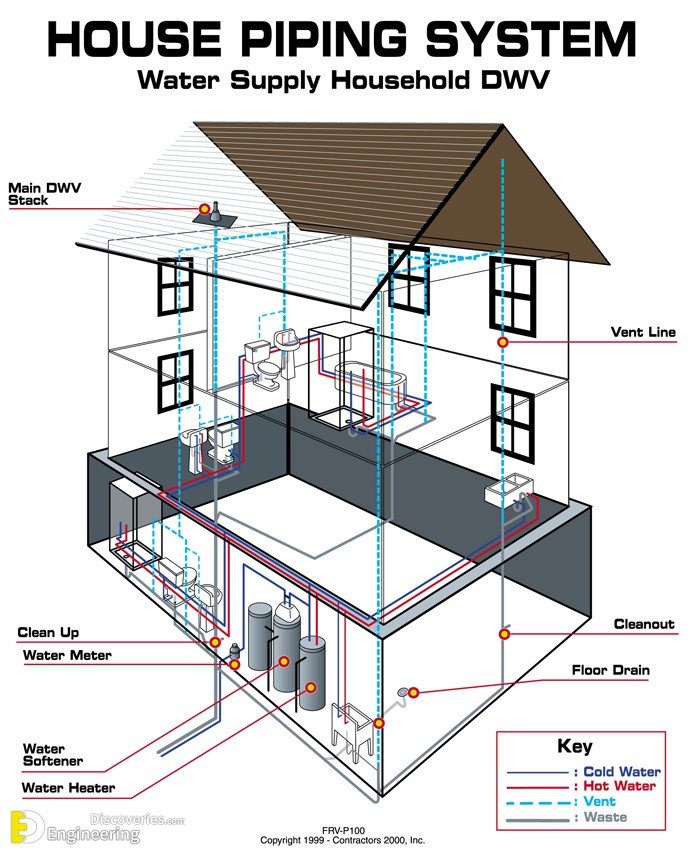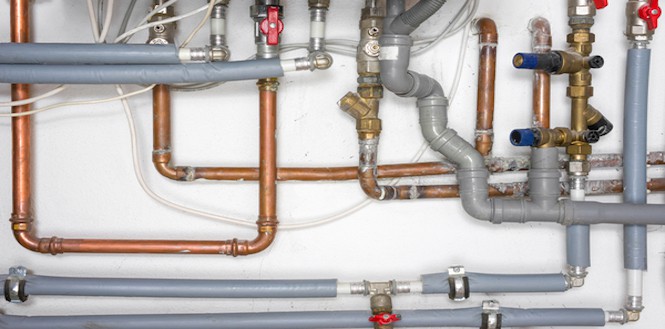How do you feel in relation to Understanding Your Home's Plumbing Anatomy?

Comprehending just how your home's plumbing system works is necessary for every property owner. From delivering tidy water for alcohol consumption, cooking, and showering to safely eliminating wastewater, a well-maintained pipes system is critical for your family's health and convenience. In this detailed guide, we'll discover the complex network that composes your home's plumbing and offer tips on upkeep, upgrades, and dealing with common problems.
Introduction
Your home's pipes system is more than simply a network of pipes; it's an intricate system that ensures you have access to tidy water and efficient wastewater elimination. Knowing its elements and exactly how they work together can aid you avoid costly repair services and guarantee every little thing runs smoothly.
Standard Components of a Plumbing System
Pipelines and Tubing
At the heart of your pipes system are the pipes and tubes that lug water throughout your home. These can be made of various materials such as copper, PVC, or PEX, each with its benefits in regards to sturdiness and cost-effectiveness.
Fixtures: Sinks, Toilets, Showers, etc.
Fixtures like sinks, toilets, showers, and tubs are where water is made use of in your home. Comprehending exactly how these components link to the pipes system helps in diagnosing problems and preparing upgrades.
Shutoffs and Shut-off Points
Valves control the flow of water in your pipes system. Shut-off shutoffs are crucial during emergencies or when you require to make repairs, allowing you to separate parts of the system without disrupting water flow to the whole residence.
Water System
Key Water Line
The main water line connects your home to the municipal water supply or an exclusive well. It's where water enters your home and is distributed to numerous components.
Water Meter and Stress Regulator
The water meter measures your water usage, while a stress regulatory authority makes sure that water streams at a risk-free stress throughout your home's pipes system, protecting against damages to pipelines and components.
Cold Water vs. Warm water Lines
Recognizing the difference in between cold water lines, which provide water directly from the primary, and hot water lines, which lug warmed water from the hot water heater, assists in fixing and preparing for upgrades.
Drain System
Drain Pipes Pipeline and Traps
Drain pipes bring wastewater away from sinks, showers, and toilets to the sewer or septic system. Traps avoid sewage system gases from entering your home and additionally catch debris that can create obstructions.
Air flow Pipes
Air flow pipes allow air into the drain system, stopping suction that might slow down drain and trigger traps to empty. Appropriate air flow is essential for maintaining the integrity of your plumbing system.
Value of Correct Drain
Ensuring correct drain avoids back-ups and water damages. Frequently cleaning drains pipes and preserving traps can protect against costly fixings and extend the life of your pipes system.
Water Heating System
Kinds Of Water Heaters
Hot water heater can be tankless or standard tank-style. Tankless heaters warm water on demand, while containers store warmed water for immediate usage.
Upgrading Your Plumbing System
Factors for Updating
Updating to water-efficient fixtures or replacing old pipelines can boost water top quality, minimize water expenses, and increase the worth of your home.
Modern Plumbing Technologies and Their Benefits
Discover innovations like smart leakage detectors, water-saving bathrooms, and energy-efficient water heaters that can conserve money and reduce ecological effect.
Expense Considerations and ROI
Calculate the in advance prices versus lasting cost savings when considering pipes upgrades. Lots of upgrades spend for themselves with minimized utility costs and fewer repairs.
Exactly How Water Heaters Connect to the Plumbing System
Understanding just how water heaters link to both the cold water supply and hot water circulation lines helps in detecting problems like not enough hot water or leakages.
Maintenance Tips for Water Heaters
On a regular basis flushing your hot water heater to remove sediment, examining the temperature setups, and inspecting for leaks can prolong its life expectancy and boost energy effectiveness.
Usual Plumbing Problems
Leaks and Their Reasons
Leakages can occur because of maturing pipes, loosened installations, or high water pressure. Attending to leakages without delay protects against water damage and mold development.
Obstructions and Blockages
Obstructions in drains pipes and bathrooms are usually triggered by purging non-flushable things or a build-up of grease and hair. Utilizing drainpipe screens and bearing in mind what drops your drains can avoid blockages.
Indicators of Plumbing Issues to Watch For
Low water pressure, sluggish drains pipes, foul odors, or abnormally high water bills are indicators of potential plumbing troubles that should be dealt with immediately.
Pipes Upkeep Tips
Regular Evaluations and Checks
Arrange yearly plumbing evaluations to capture issues early. Seek indications of leakages, deterioration, or mineral build-up in faucets and showerheads.
DIY Maintenance Tasks
Basic jobs like cleaning faucet aerators, checking for bathroom leaks making use of color tablet computers, or insulating subjected pipelines in chilly environments can prevent major plumbing issues.
When to Call an Expert Plumbing Professional
Know when a pipes problem requires specialist experience. Trying complex repairs without proper knowledge can result in even more damages and greater repair service expenses.
Tips for Minimizing Water Use
Basic routines like dealing with leakages without delay, taking much shorter showers, and running complete lots of washing and recipes can preserve water and reduced your energy costs.
Eco-Friendly Plumbing Options
Consider sustainable pipes products like bamboo for flooring, which is durable and environment-friendly, or recycled glass for counter tops.
Emergency Preparedness
Steps to Take Throughout a Pipes Emergency situation
Know where your shut-off shutoffs are located and exactly how to shut off the water system in case of a ruptured pipe or major leak.
Significance of Having Emergency Calls Useful
Maintain call details for local plumbings or emergency services easily available for fast response throughout a pipes dilemma.
Environmental Effect and Preservation
Water-Saving Fixtures and Home Appliances
Installing low-flow faucets, showerheads, and commodes can considerably minimize water usage without giving up performance.
DIY Emergency Situation Fixes (When Applicable).
Momentary repairs like making use of duct tape to spot a dripping pipe or positioning a bucket under a dripping tap can minimize damages till a specialist plumber shows up.
Conclusion.
Understanding the anatomy of your home's pipes system encourages you to preserve it efficiently, saving time and money on repair work. By complying with regular maintenance routines and remaining educated regarding contemporary plumbing innovations, you can ensure your plumbing system operates efficiently for several years ahead.
The Anatomy of Your Home s Plumbing System
Understanding the anatomy of your home s plumbing system is essential for any homeowner. It not only helps in identifying potential issues but also facilitates effective communication with professionals when repairs or upgrades are needed. Your home s plumbing system is more than just pipes and faucets; it s a complex network that ensures the efficient and hygienic flow of water in and out of your house. In this blog, we ll dissect the crucial components of your home s plumbing system. For those in Antelope Valley, Brock Plumbing is your trusted partner for all your plumbing needs, ensuring your system functions smoothly and efficiently.
Water Supply System
Main Water Line: This is where your home s plumbing system begins. The main water line connects your home to the public water supply or a private well. Pipes and Shut-off Valves: Pipes distribute water throughout your home. Shut-off valves are crucial for controlling the flow of water and making repairs without shutting off the entire system. Drainage System
Drain Pipes: These pipes carry waste and water away from sinks, toilets, and showers. Vents: Vents allow sewer gases to escape and help maintain proper pressure in the drainage pipes, ensuring efficient flow of wastewater. Traps: Every fixture has a trap, a U-shaped pipe that holds water and prevents sewer gases from entering your home. The most common is the P-trap under sinks. Fixtures and Appliances
Fixtures and appliances are the most interacted with parts of your plumbing system. They include sinks, toilets, showers, dishwashers, and washing machines. Each fixture and appliance has its own supply and drainage connection, ensuring they receive clean water and can dispose of wastewater effectively.
Water Heating System
Your water heater is a crucial component, providing hot water to various fixtures and appliances in your home. It can be tank-based or tankless, with each type having its own set of advantages and maintenance requirements. Regular maintenance is essential to ensure efficient operation and extend the lifespan of the unit.
Sump Pump
In areas prone to flooding or with high water tables, a sump pump is an essential part of the plumbing system. It s installed in the lowest part of your basement or crawlspace and pumps out water that accumulates, preventing flooding and protecting your home from water damage.
Septic System
Homes that are not connected to a municipal sewer system have a septic system and an underground wastewater treatment structure. Understanding how to maintain your septic system is crucial to prevent backups, odors, and early system failure.
Conclusion
Your home s plumbing system is a complex and essential network, ensuring the efficient and hygienic flow of water in and out of your property. Understanding its key components helps in maintaining it properly and identifying issues before they escalate into major problems. For residents in Antelope Valley, Brock Plumbing is dedicated to providing top-notch services, ensuring that every part of your plumbing system is in perfect working order. Trust our team of professionals to handle all your plumbing needs, ensuring your home remains comfortable, safe, and well-maintained.
https://brockplumbinganddrains.com/blog/the-anatomy-of-your-homes-plumbing-system/

I have been very inquisitive about Plumbing Installation 101: All You Need to Know and I really hope you appreciated the entire post. If you enjoyed reading our blog entry please be sure to pass it around. I am grateful for being here. Revisit us soon.
Request Appointment